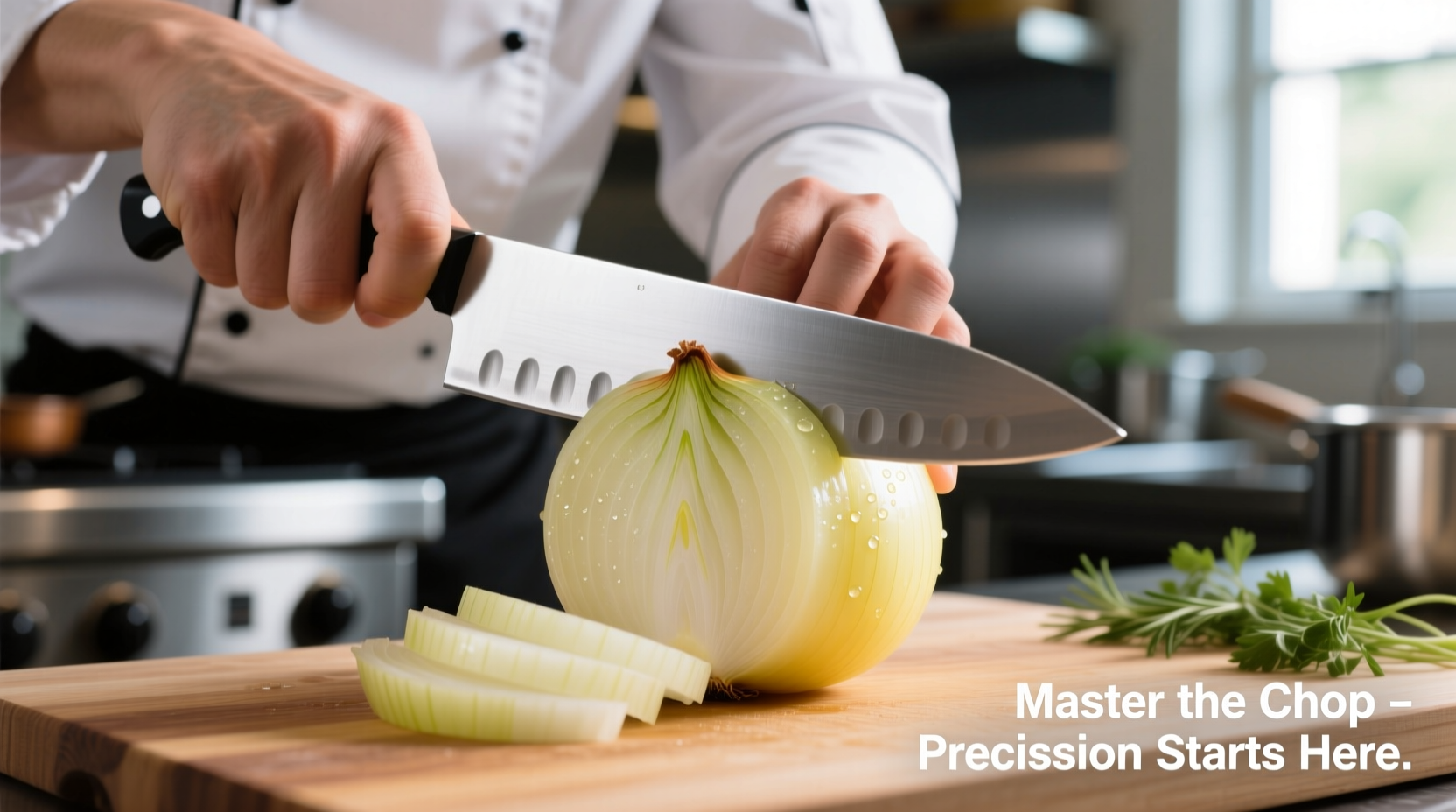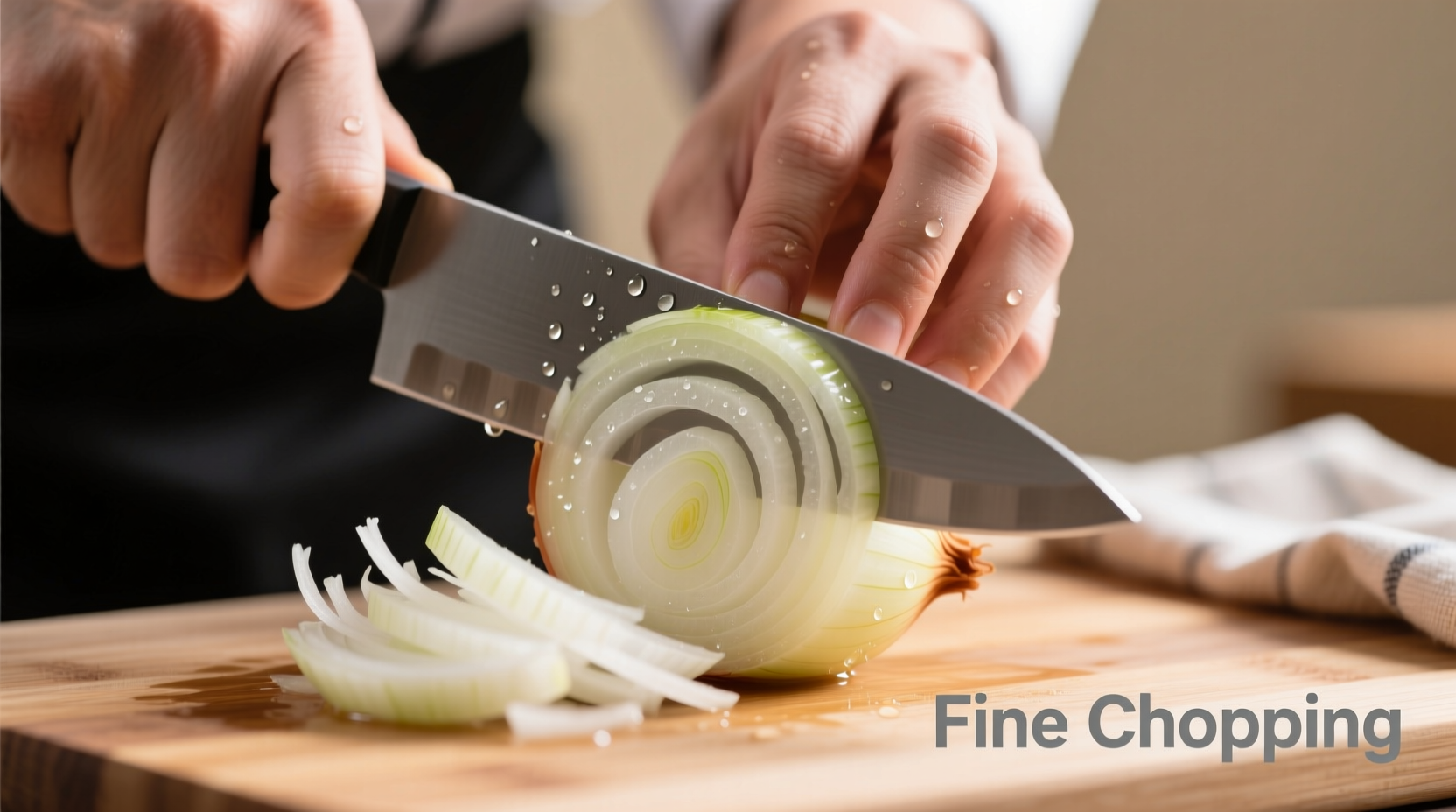Master the Art of Perfect Onion Chopping
Whether you're preparing a delicate French sauce or a vibrant salsa, finely chopped onions form the flavor foundation for countless dishes. This precise technique separates amateur cooks from professionals, directly impacting texture, flavor distribution, and cooking time in your recipes.
Why Fine Chopping Matters in Cooking
When recipes specify "finely chopped" rather than diced or sliced, they're calling for a specific culinary outcome. Fine chopping creates maximum surface area, allowing onions to:
- Release flavors more quickly and evenly into dishes
- Blend seamlessly without overpowering other ingredients
- Cook faster and more uniformly, preventing burnt bits
- Create smooth textures in sauces and dressings
Professional chefs understand that the difference between a mirepoix and a sofrito often comes down to the precision of your onion chop. In French cuisine, a brunoise cut (1/8 inch dice) requires first creating a fine chop as the foundation.
Essential Tools for Perfect Results
You don't need specialized equipment, but having the right basics makes all the difference:
- 8-10 inch chef's knife: A sharp, well-balanced knife provides control and reduces hand fatigue
- Stable cutting board: Wood or composite boards protect your knife edge better than glass
- Damp kitchen towel: Place under cutting board to prevent slipping
According to the USDA Food Safety and Inspection Service, always use a dedicated cutting board for produce to prevent cross-contamination with raw meats.
Step-by-Step Technique for Perfectly Fine Chopped Onions
Follow this professional method to achieve consistent results every time:
Preparation Phase
- Refrigerate the onion for 30 minutes before chopping (reduces tear-inducing compounds)
- Cut off the stem end while keeping the root intact
- Peel away outer layers and cut the onion in half vertically through the root
Cutting Technique
- Place each half flat-side down on the cutting board
- Make horizontal cuts from the top toward (but not through) the root end
- Make vertical cuts from stem to root, maintaining consistent spacing
- Finally, slice across the onion perpendicular to your previous cuts
- Repeat with the second half
| Onion Cut Type | Size | Best For |
|---|---|---|
| Finely Chopped | 1/8 inch | Sauces, dressings, delicate dishes |
| Diced | 1/4-1/2 inch | Salsas, stir-fries, soups |
| Sliced | 1/8-1/4 inch rings | Caramelizing, burgers, sandwiches |
Troubleshooting Common Problems
Problem: Uneven pieces after chopping
Solution: Maintain consistent spacing between cuts and keep your knife blade perpendicular to the cutting board. Professional chefs use the "claw grip" with their non-knife hand to control both safety and consistency.
Problem: Excessive tearing while chopping
Solution: Keep the root end intact until final chopping, work near running water, or chill onions before cutting. The American Chemical Society explains that chilling reduces the enzyme reaction that creates tear-inducing compounds.
Problem: Onion pieces sticking to knife
Solution: Wipe your blade with a damp cloth between cuts or use a knife with a Granton edge (hollow-ground blades).

Storing Your Finely Chopped Onions
Proper storage maintains quality and safety:
- Store in airtight container in refrigerator
- Use within 2-3 days for best flavor and texture
- Place paper towel in container to absorb excess moisture
- Never store at room temperature for more than 2 hours
The FDA Food Code recommends discarding any perishable food left at room temperature for more than two hours to prevent foodborne illness.
When to Use Fine Chopped Onions
Certain dishes specifically benefit from fine chopping:
- French sauces: Bechamel, velouté, and demi-glace require fine mirepoix
- Asian stir-fries: Fine chop ensures even distribution in quick-cooking dishes
- Salad dressings: Creates emulsion without large chunks
- Meatloaf and burgers: Distributes flavor without creating texture pockets
As culinary expert Harold McGee notes in On Food and Cooking, "The size of vegetable pieces determines how quickly they cook and how completely their flavors blend with other ingredients."
Advanced Tips from Professional Kitchens
Master chefs employ these techniques for perfect results:
- Rinse chopped onions in cold water to remove excess sugars for raw applications
- Use a mandoline with julienne blade for ultra-consistent fine chops
- Chop near an open flame (like a gas stove) to neutralize tear-inducing compounds
- Always cut against the grain of the onion layers for cleaner results
Common Questions About Onion Chopping
Here are answers to frequently asked questions about this essential kitchen skill:











 浙公网安备
33010002000092号
浙公网安备
33010002000092号 浙B2-20120091-4
浙B2-20120091-4